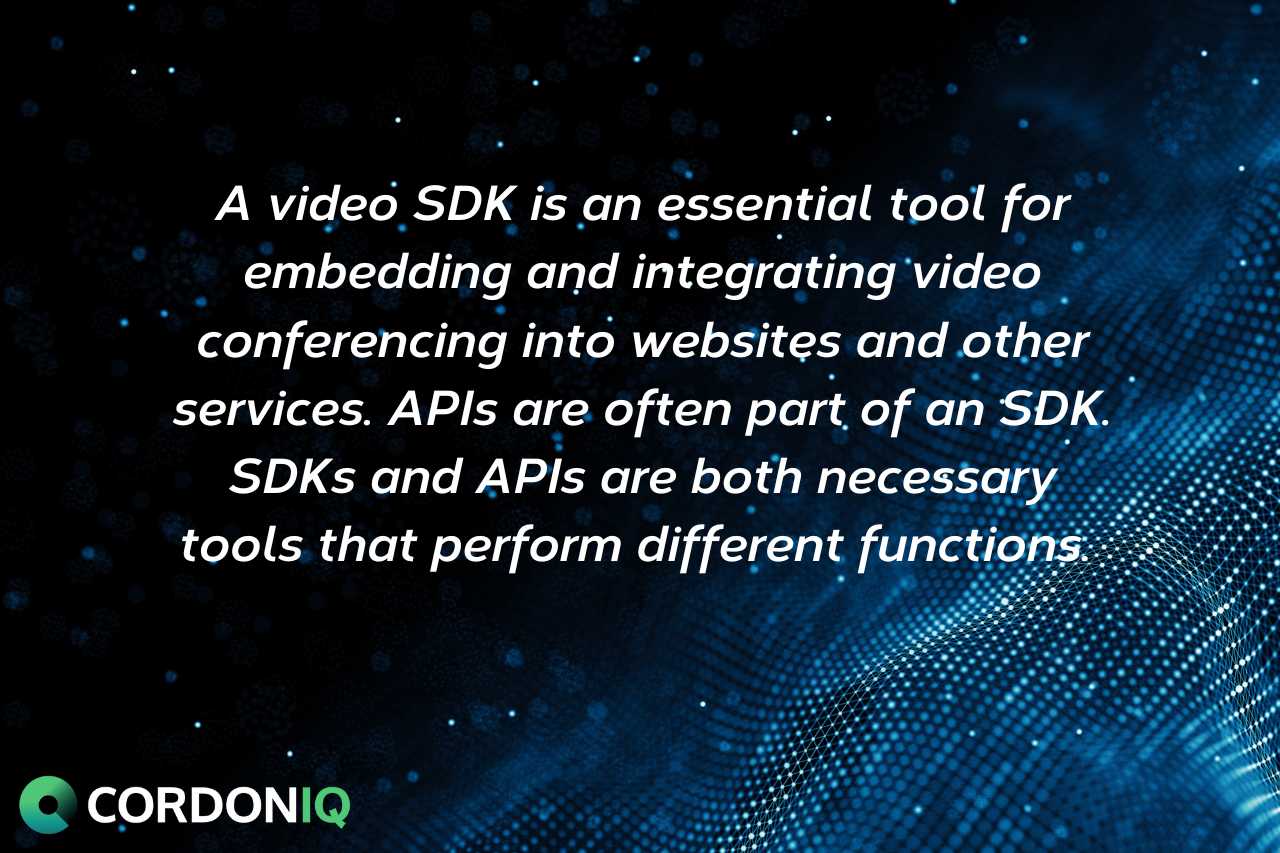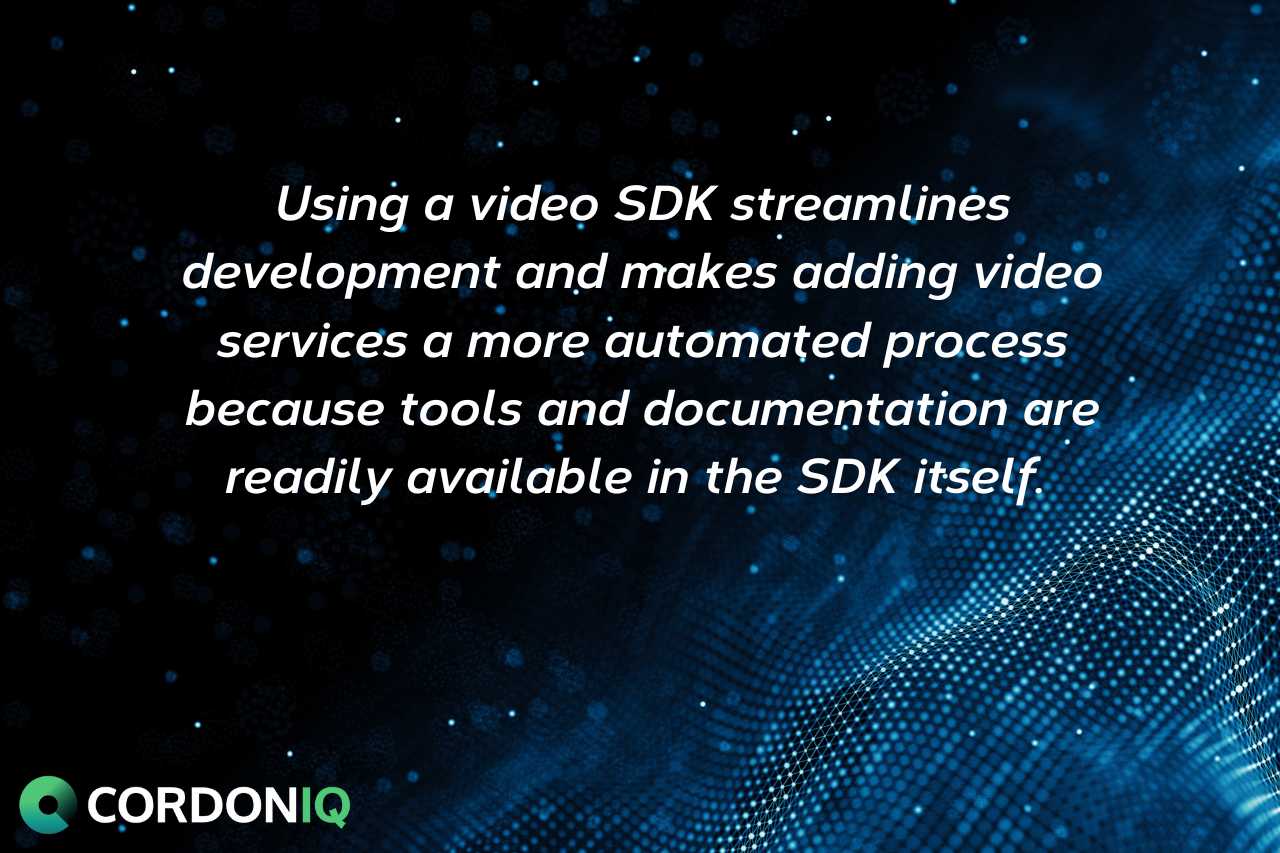Modern cloud-native software development utilizes several core practices, including microservices architecture. One element of these core practices is the specific tools that developers use to build cloud-native applications. Two essential tools are the software development kit (SDK) and the application programming interface (API).
An SDK is a key tool that allows developers to build applications for specific platforms. A video SDK is an essential tool for embedding and integrating video conferencing into websites and other services. APIs are often part of an SDK. SDKs and APIs are both necessary tools that perform different functions.

In this blog article, we’ll cover some of the basics of video conferencing SDKs, how they differ from APIs, and the benefits of using video SDKs for applications.
What is an SDK?
An SDK, which is also called a devkit, is a tool that allows developers to build applications faster and in a more streamlined approach. SDKs eliminate the need for coding an entire application from scratch, a time-consuming and tech-resource-intensive process. Tools such as SDKs are a cost-effective solution.
As IBM notes, “ SDKs provide a comprehensive collection of tools that enable software developers to build software applications faster and in a more standardized way.”
SDKs include the core components that developers require to build specific applications including:
- APIs
- Documentation
- Code libraries and frameworks
- Testing/analysis tools
- Network protocols
- Drivers
Often, SDKs provide tools needed to build apps for a specific cloud platform, such as AWS or Google. There are also mobile platform SDKs for Android and iOS. Additionally, SDKs allow communications between mobile apps and cloud-based services.

What are some examples of SDKs?
SDKs are not only platform-specific but can also be programming language-specific.
Here are examples of popular SDKs:
- Programming language-specific SDKs – JSON, Java Development Kit, MS Windows SDK
- Platform-specific SDKs: Google Cloud SDK, AWS SDK
- Mobile: MacOs X SDK, iPhone SDK, Android SDK
What is a video SDK?
A video SDK is an essential tool that makes it faster and easier for developers to add and integrate video services to different types of applications and environments, including websites. Typical services that developers can build or add with a video SDK include live streaming, audio, screen sharing, chat, messaging, communications, and recording. With an SDK, everything needed to add video services to applications is included.
Components of a video SDK would include APIs, libraries and various pre-built components for live video streaming, audio and other related services. With a video SDK, web services can be added for the cloud, or for mobile applications in iOS or Android.
What are the differences between SDK and API?
SDKs and APIs are both foundational tools for cloud-native development, microservices architecture, and platform integration. These essential tools for development have different functions. The SDK contains the tools a developer needs to build an app or service.
SDKs typically include APIs, which are a set of definitions and protocols used for building and integrating application software. While APIs allow two applications to talk to each other, they can also be considered a type of contract for exchanging information.
SDKs and APIs are both essential tools for platform integration, including Software as a Service (SaaS) solutions and Platform as a Service (PaaS) solutions, such as a video conferencing platform API .
What are the benefits of a video SDK?
Along with saving time and money, using a video SDK comes with benefits including:
- Scalability and flexibility
- Adaptability
- Cost-effectiveness
- Speed and efficiency
- Platform agnosticism
Using a video SDK streamlines development and makes adding video services a more automated process because tools and documentation are readily available in the SDK itself.

Leverage Cordoniq’s platform for a customized solution
Developers can leverage the agility of the Cordoniq video collaboration platform to create secure solutions that can be customized depending on the specific needs of an organization or industry requirements.
Cordonig provides all developer tools including SDKs and APIs, as well as programming assistance. With Cordoniq’s tools you can deploy a secure custom video conferencing and collaboration solution, using containers and incorporating yours or your clients’ specific requirements, to a private network or cloud.
Developers and clients can automatically integrate Cordoniq’s APIs with the following programming languages, tools and programming platforms, as well as many more:
- JavaScript (angularjs or nodejs)
- Python
- C# (.net 2.0, 3.5 or later)
- Java (Jersey1.x, Jersey2.x, OkHttp, Retrofit1.x, Retrofit2.x, Feign, RestTemplate, RESTEasy, Vertx, Google API, Client Library for Java, Rest-assured)
- Typescript (Angular1.x, Angular2.x, Fetch, jQuery, Node)
- PHP
- C++ (cpprest, Qt5, Tizen)
- Access the complete list in our Developer Center